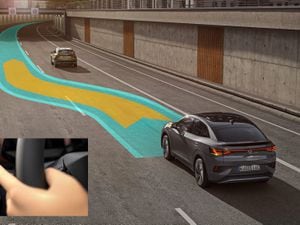Driver assistance systems: What are they and what do they do?
Modern cars are packed full of technology – but what do you need to know about them?

Modern cars are jam-packed with assistance technology. Designed to make cars safer and easier to live with, they apply to all areas of a vehicle’s make-up. Accompanied by a dizzying array of terms and meanings, deciphering just what these systems do can be tricky at times.
This is why we’ve picked out some key assistance systems you need to know about and how they can benefit you.
Adaptive Cruise Control

Adaptive Cruise Control is a function that can take the legwork out of longer journeys. Whereas regular cruise control simply maintains a predetermined speed, Adaptive Cruise Control keeps a set distance from the vehicle in front by using a radar mounted to the front of your vehicle.
So when the car ahead speeds up, you’ll speed up too and settle down once you reach a pre-set speed. Plus, when traffic slows down, the car will automatically slow down too.
Autonomous Emergency Braking

Autonomous Emergency Braking – or AEB – is a really clever bit of technology aimed at making cars safer. It operates by using a combination of radar, cameras or lidar to scan the road ahead. It’ll combine this information with your car’s speed and direction to determine whether the vehicle is on course for a collision.
If it detects an impact, the system will sound an alarm and accompany this with a visual alert on the driver’s display. If the driver takes no action, the system will automatically trigger the brakes and perform an emergency stop. All of this happens in super-fast time and can react far quicker than a human could. Though it may not avoid a collision entirely, it can drastically reduce the speed leading up to an impact.
Blind Spot Warning

Blind Spot Warning is pretty self-explanatory. It’s a system which will warn you if a vehicle is in your blind spot, which is particularly useful when you’re on the motorway. Some vehicles accompany this with an audible alert while illuminating a small section of the wing mirror that is on the side of the vehicle located within the blind spot.
Forward collision warning

Forward Collision Warning is slightly different to AEB because it requires the driver to take action and can’t automatically apply the brakes. It can, however, send an alert should it detect an obstacle, pedestrian, or vehicle in your car’s path.
Lane Departure Warning

Lane Departure Warning systems use a camera mounted within the car – mostly located behind the rear-view mirror – which scans the road ahead to detect the white lines of your lane.
If it notices that the car is straying towards the line, it will sound an alert while also displaying a warning on the dashboard. However, this alert is disabled if the driver operates the indicators before changing lanes.
Lane Keep Assist

Lane Keep Assist takes Lane Departure Warning systems one step further. While using the same information, it can actively steer the vehicle if it senses that it is straying towards the white lines of the lane. Much the same as before, a warning is sounded too.
However, this isn’t a ‘self-driving’ system. Far from it, if the system notices that the driver has taken their hands away from the steering wheel, it will sound an alert and then disengage the assistance.
Parking Assist

Parking Assist can be a real bonus for those drivers who live in busy towns and have to park in smaller spaces. They’re able to assess the road as you drive by it, check for a space and determine whether or not it is large enough to accommodate your car.
From there, all the driver is required to do is operate the throttle and brakes. The car’s system will operate the steering, ensuring that you get inch-perfect parking every time.





